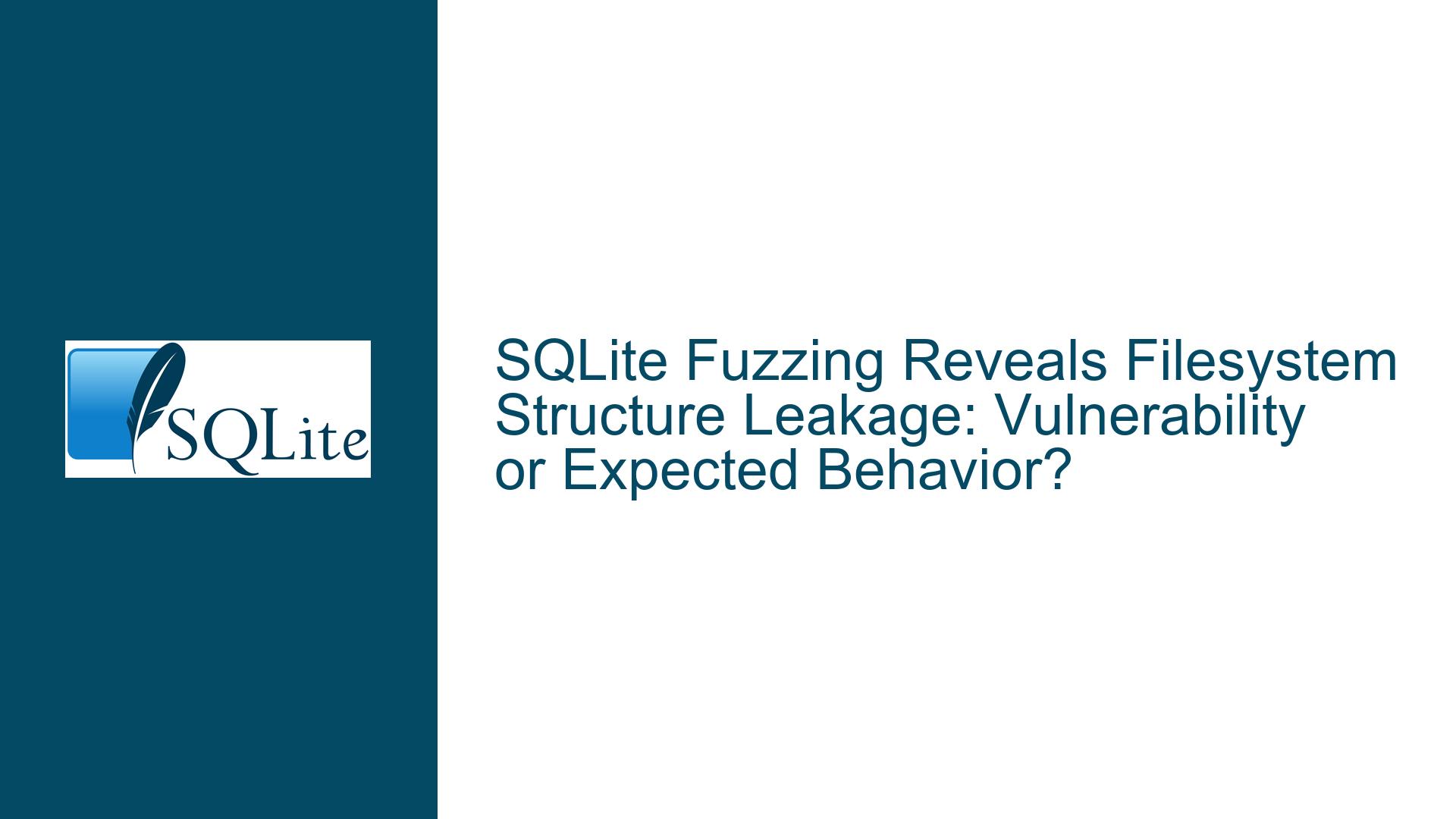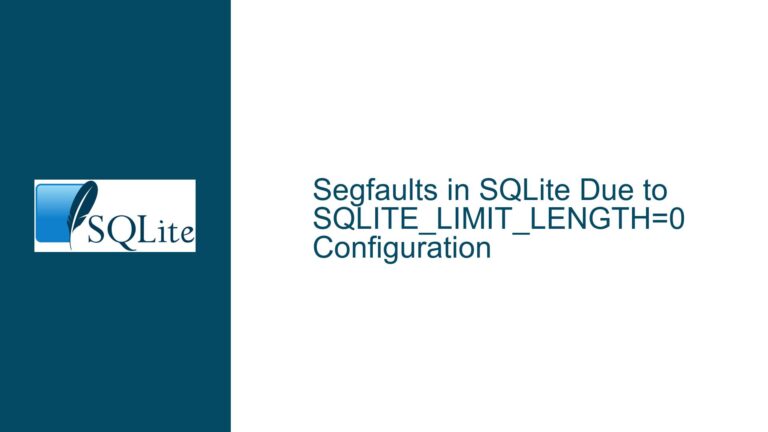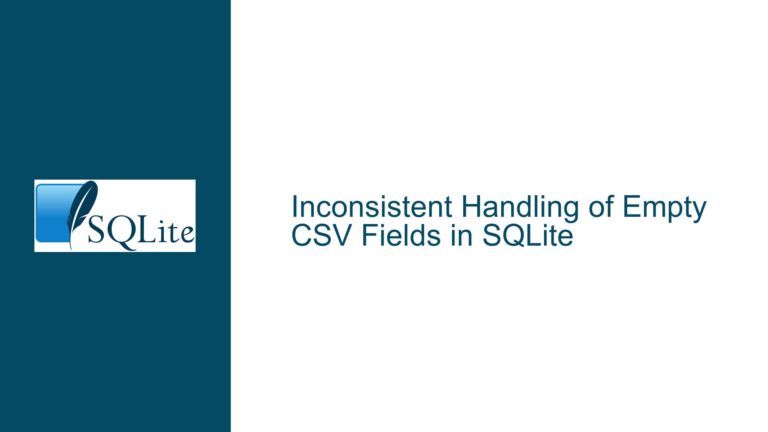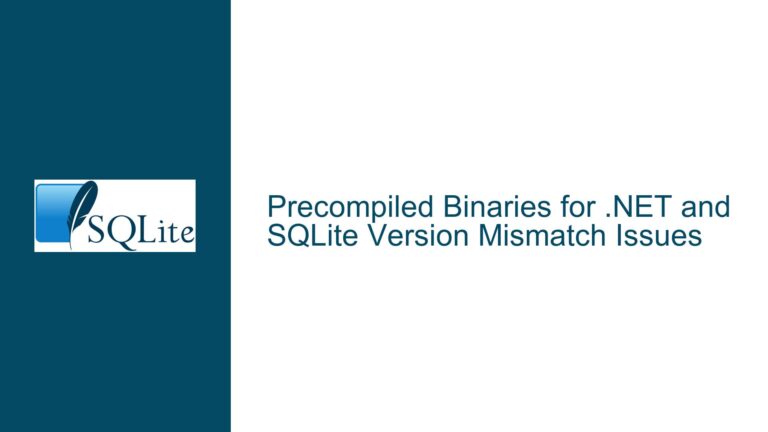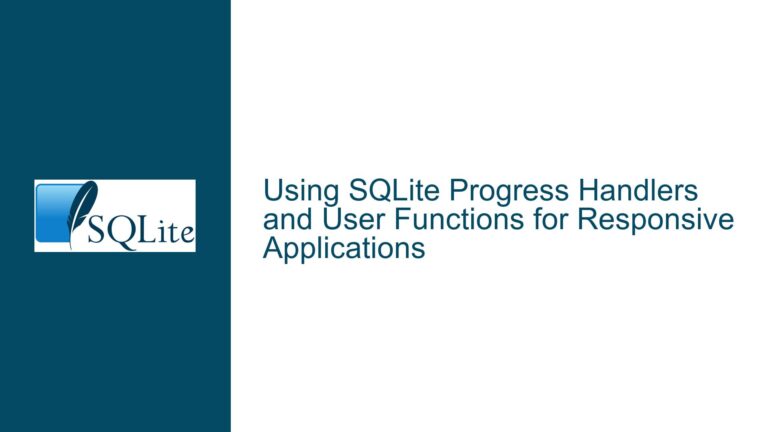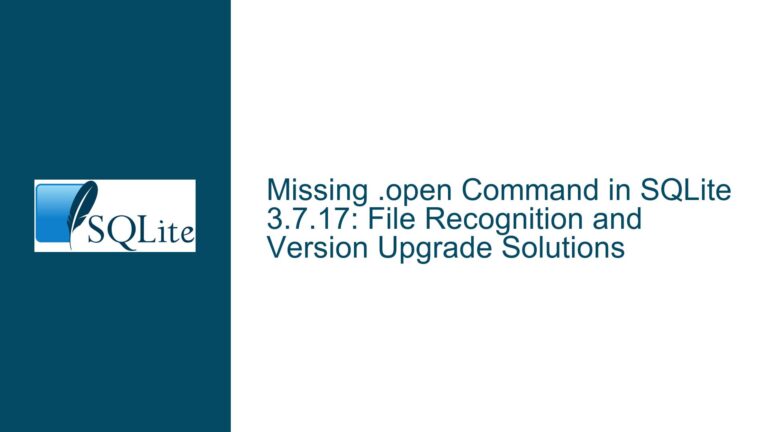SQLite Fuzzing Reveals Filesystem Structure Leakage: Vulnerability or Expected Behavior?
Understanding SQLite’s Response to Malformed Init Scripts
When working with SQLite, one of the most robust and widely-used embedded database engines, it is crucial to understand how it handles unexpected or malformed inputs. In this case, the issue revolves around SQLite’s behavior when an unusual or malformed initialization script is provided. Specifically, the fuzzer-generated test case causes SQLite to output what appears to be filesystem structure information. This behavior raises questions about whether this is a vulnerability, a bug, or an expected outcome given the nature of the input.
SQLite is designed to be highly resilient and secure, but like any software, it has edge cases that can produce unexpected results. The initialization script is a critical part of setting up a database session, and any anomalies in its execution can lead to unintended consequences. The filesystem structure leakage observed here could be a side effect of how SQLite processes certain malformed commands or handles errors during the initialization phase.
To fully grasp the implications, it is essential to delve into the mechanics of SQLite’s initialization process. When SQLite starts, it reads and executes the provided initialization script, which can include SQL commands, pragmas, and other directives. If the script contains malformed or unexpected content, SQLite’s error handling mechanisms come into play. These mechanisms are designed to gracefully handle errors, but in some cases, they might produce outputs that reveal internal state or system information.
The filesystem structure leakage could be a result of SQLite attempting to resolve paths or access resources referenced in the malformed script. For example, if the script includes invalid file paths or references to non-existent files, SQLite might generate error messages that include filesystem information. This behavior, while potentially concerning, might not necessarily indicate a vulnerability but rather a side effect of how SQLite handles such edge cases.
Understanding the context in which this behavior occurs is crucial. Fuzzing, a technique used to discover vulnerabilities by providing random or malformed inputs, often uncovers edge cases that are not typically encountered in normal usage. The fact that the fuzzer was able to produce this output suggests that the input was highly unusual and likely not something that would be encountered in typical database operations.
In summary, the observed behavior of SQLite outputting filesystem structure information in response to a malformed initialization script is a complex issue that requires a detailed examination of SQLite’s initialization process, error handling mechanisms, and the specific nature of the input that triggered this behavior.
Exploring the Root Causes of Filesystem Structure Leakage
The filesystem structure leakage observed in SQLite when processing a malformed initialization script can be attributed to several potential causes. Understanding these causes is essential for determining whether this behavior constitutes a vulnerability or is simply an expected outcome given the nature of the input.
One possible cause is the way SQLite handles file-related operations during the initialization phase. SQLite often interacts with the filesystem to open database files, create temporary files, or access other resources. If the initialization script includes commands that reference files or directories, SQLite will attempt to resolve these references. In the case of a malformed script, SQLite might encounter errors while trying to resolve invalid paths or access non-existent files. These errors could result in error messages that inadvertently reveal filesystem structure information.
Another potential cause is the behavior of SQLite’s error reporting mechanisms. SQLite is designed to provide detailed error messages to help developers diagnose and fix issues. However, in some cases, these error messages might include more information than intended, such as filesystem paths or other system details. This could be particularly problematic if the error messages are exposed to end-users or logged in a way that could be accessed by unauthorized parties.
The specific nature of the malformed input also plays a significant role in triggering this behavior. Fuzzing often generates inputs that are highly unusual and not representative of typical usage. The test case that produced the filesystem structure leakage might have included commands or syntax that SQLite was not designed to handle gracefully. For example, the script might have included invalid SQL commands, malformed pragmas, or references to non-standard resources. When SQLite encounters such inputs, it might produce unexpected outputs as it attempts to process or recover from the errors.
Additionally, the environment in which SQLite is running could influence its behavior. SQLite is designed to be highly portable and can run in a variety of environments, each with its own filesystem structure and security settings. The observed behavior might be specific to certain environments or configurations, making it difficult to reproduce or diagnose in other contexts.
It is also worth considering the role of SQLite’s internal state and how it manages resources during the initialization phase. SQLite maintains various internal data structures and caches to optimize performance and manage resources efficiently. If the initialization script causes SQLite to enter an unexpected state, it might produce outputs that reflect its internal state, including filesystem information.
In conclusion, the filesystem structure leakage observed in SQLite when processing a malformed initialization script can be attributed to a combination of factors, including SQLite’s handling of file-related operations, its error reporting mechanisms, the nature of the malformed input, the environment in which it is running, and its internal state management. Understanding these root causes is essential for determining whether this behavior constitutes a vulnerability or is simply an expected outcome given the specific circumstances.
Mitigating Filesystem Structure Leakage in SQLite: Best Practices and Solutions
Addressing the issue of filesystem structure leakage in SQLite when processing malformed initialization scripts requires a multi-faceted approach that includes both preventive measures and reactive solutions. By understanding the root causes and implementing best practices, developers can mitigate the risks associated with this behavior and ensure the security and stability of their SQLite-based applications.
One of the most effective ways to prevent filesystem structure leakage is to validate and sanitize all inputs before they are processed by SQLite. This includes initialization scripts, SQL commands, and any other inputs that might influence SQLite’s behavior. Input validation should ensure that all commands and references are well-formed and conform to expected patterns. Sanitization should remove or escape any potentially harmful content that could trigger unexpected behavior. By implementing robust input validation and sanitization, developers can reduce the likelihood of encountering malformed inputs that could lead to filesystem structure leakage.
Another important preventive measure is to configure SQLite’s error reporting mechanisms to minimize the amount of information exposed in error messages. SQLite provides various options for controlling the verbosity and content of error messages. Developers should configure these options to ensure that error messages do not include sensitive information, such as filesystem paths or internal state details. This can be achieved by setting appropriate error handling callbacks or using SQLite’s built-in mechanisms for controlling error message content.
In addition to preventive measures, developers should also implement reactive solutions to handle cases where filesystem structure leakage might occur. This includes monitoring and logging SQLite’s behavior to detect and respond to unusual outputs. By analyzing logs and monitoring for patterns that indicate potential issues, developers can quickly identify and address any instances of filesystem structure leakage. This proactive approach can help mitigate the impact of such issues and prevent them from being exploited.
Another reactive solution is to implement custom error handling routines that intercept and process SQLite’s error messages before they are exposed to end-users or logged. These routines can filter out sensitive information, such as filesystem paths, and replace them with generic placeholders or more secure alternatives. By customizing error handling in this way, developers can ensure that sensitive information is not inadvertently exposed.
It is also important to consider the environment in which SQLite is running and how it interacts with the filesystem. Developers should ensure that SQLite is running in a secure environment with appropriate permissions and access controls. This includes restricting access to sensitive files and directories, using secure file paths, and implementing proper filesystem permissions. By securing the environment, developers can reduce the risk of filesystem structure leakage and other potential security issues.
Finally, developers should stay informed about updates and patches for SQLite that address known issues and vulnerabilities. The SQLite development team regularly releases updates that include security fixes and improvements. By keeping SQLite up to date, developers can benefit from the latest security enhancements and reduce the risk of encountering issues related to filesystem structure leakage.
In conclusion, mitigating filesystem structure leakage in SQLite requires a combination of preventive measures, reactive solutions, and best practices. By validating and sanitizing inputs, configuring error reporting mechanisms, monitoring and logging behavior, implementing custom error handling routines, securing the environment, and staying informed about updates, developers can effectively address this issue and ensure the security and stability of their SQLite-based applications.
